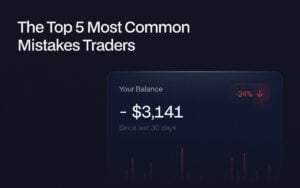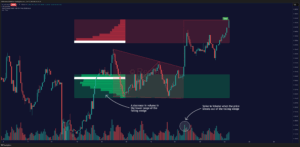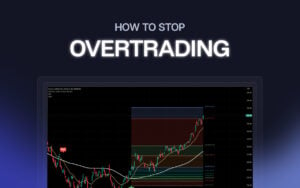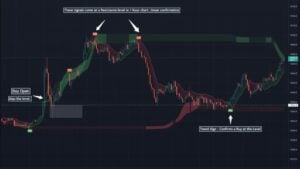Trading is a complex activity requiring great skill and knowledge. It is also subject to a variety of biases that can have a significant impact on the success or failure of a trade.
More importantly, how these biases affect us depends on our personality traits, strengths, and weaknesses as traders. You may be prone to confirmation bias, while veteran traders like myself might be stuck with anchoring bias.
This article will discuss five of the most important biases in trading and how they can affect your trading decisions. We will also discuss identifying and managing these biases to maximize your trading success.
What are the five important trading biases?
1. Confirmation Bias
It is when traders only look for information confirming their beliefs. This leads to traders ignoring important information that could help make more informed decisions.
Confirmation bias is a cognitive bias that can significantly impact trading performance. The biggest downside is that it leads to overconfidence in our beliefs and poor decision-making.
For example, you may be biased toward a particular stock and more likely to buy it even if the evidence suggests otherwise. Moreover, confirmation bias can also make you ignore evidence contradicting your beliefs.
My Advice:
To avoid confirmation bias, just be aware of it. Acknowledge your biases toward or against a particular stock and actively seek information without prejudice. This could mean stepping back and objectively evaluating the evidence before deciding.
By being aware of confirmation bias and taking steps to reduce its impact, traders can improve their trading performance and make better decisions.
2. Herd Mentality
Herding bias occurs when investors make decisions based on the actions of other investors rather than on their own market analysis. This can lead to knee-jerk decisions without considering the market’s fundamentals.
This type of bias can lead to market bubbles, where investors are regularly buying a stock based on the actions of other investors or influencers.
Such buys can lead to the overvaluation of a stock. This can lead to a market crash or “market correction,” as investors may be selling a stock based on the actions of others.
My Advice:
Herding bias can be avoided by conducting thorough research and analysis of the market. You should be prepared to take action if you feel your decisions are being influenced by other investors.
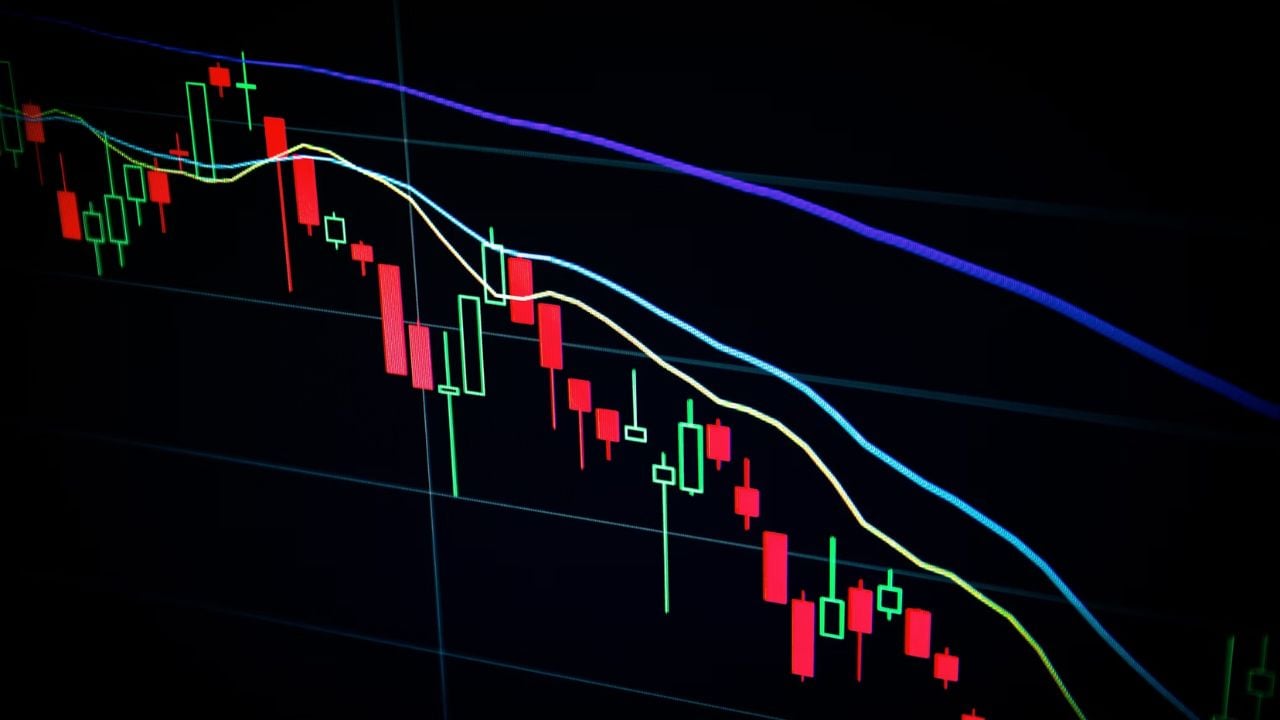
3. Loss Aversion
Loss Aversion is a peculiar cognitive bias when traders focus more on avoiding losses than making profits. This causes traders to hold onto losing positions for too long or exiting winning positions too soon.
This bias can impact your trading strategy fundamentally, leading to irrational decisions and losses.
When faced with the possibility of a loss, we may be more inclined to take uncalculated risks to avoid the loss. That’s overtrading, and that’s bad.
On the flip side, you incur a loss if you hold onto losing positions for too long. This can lead to further losses as the market moves against you.
Loss aversion bias leads to missed opportunities, as traders may be too conservative and miss out on potential profits.
My Advice: One way to do this is to set clear trading rules and stick to them. This can help you make decisions based on rational analysis rather than emotional reactions.
4. Anchoring Bias
Anchoring Bias occurs when traders rely too heavily on past information for making decisions. It leads to missing out on potential opportunities or making decisions based on outdated information.
This outdated piece of information, known as an anchor, can have a significant impact on the decisions that are made. In the trading context, anchoring bias can lead to poor performance if not managed properly.
Anchoring bias manifests in various ways. For example, you may become overly focused on a particular price level or indicator and be reluctant to move away. This could lead to missed opportunities or losses if the market moves differently.
My Advice: Traders should strive to remain objective and open-minded when making decisions. It is important to consider all available information and to be willing to adjust positions if the market conditions change.
5. Overconfidence Bias
This bias occurs when traders overestimate their ability to predict the markets and make successful trades. This can lead to excessive risk-taking and poor decision-making.
As with almost every other aspect of life, overconfidence bias can be especially dangerous in trading. That’s because your decisions here have significant financial consequences.
For example, an individual may overestimate their ability to predict the market’s direction, leading them to take on more risk than they can handle.
They may also overestimate their ability to time the market, leading them to enter and exit positions at the wrong times. Additionally, they may overestimate their ability to identify profitable trades, leading them to take on less likely profitable trades.
My Advice: The first step is to accept and be aware of your limitations. Become willing to seek out advice from more experienced traders. Look for data to back up your decisions and always take a step back to try and look at the bigger picture.
How to avoid biases in trading?
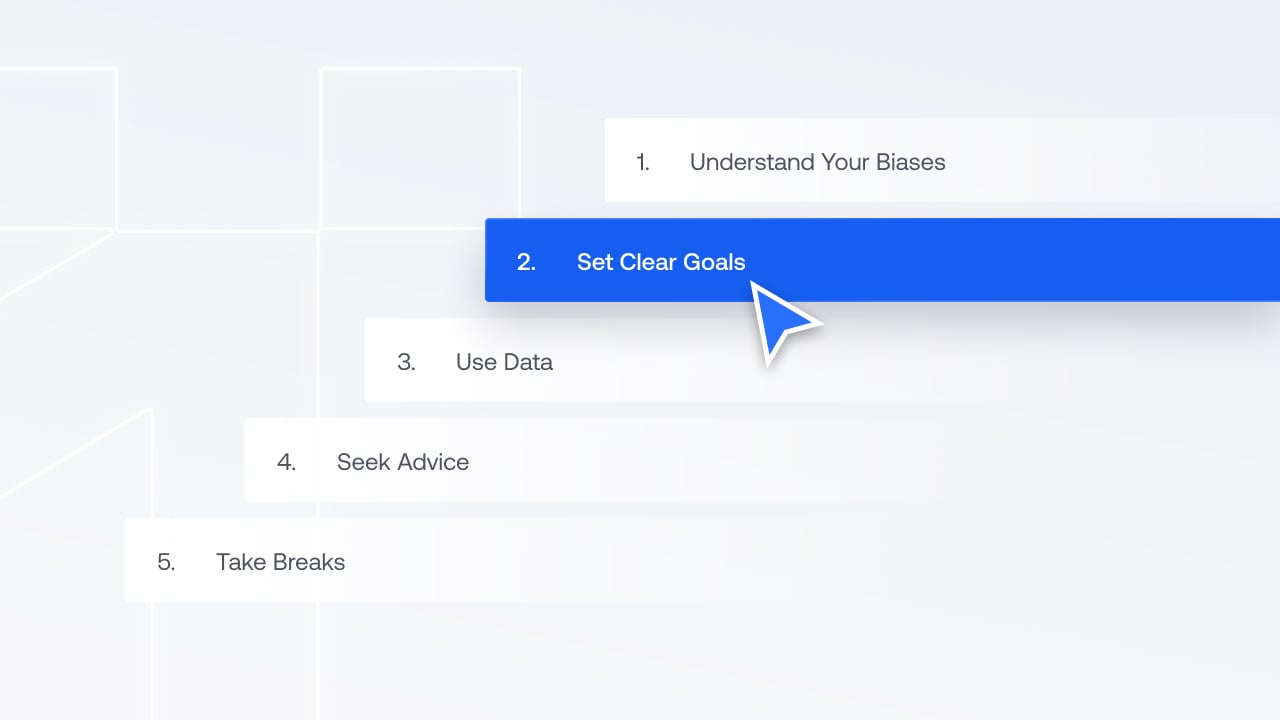
Here’s what you gotta do to protect yourself from trading biases and make calculated decisions:
1. Understand Your Biases: Understanding a trading bias is the first step to avoiding it. Take the time to identify any potential biases affecting your trading decisions and be aware of how they may influence your decisions.
2. Set Clear Goals: Establishing clear goals and objectives for your trading can help you stay focused and avoid uncalculated risks. Ensure your goals are realistic, achievable, and aligned with your trading strategy.
3. Use Data: Using data to inform your trading decisions can help avoid bias. Make sure that you are using reliable data sources and that you are analyzing the data objectively.
4. Seek Advice: Seeking advice from experienced traders can help you identify potential biases and make better trading decisions. Ensure you get advice from someone knowledgeable and experienced in the market.
5. Take Breaks: Taking breaks from trading can help you avoid making decisions based on emotion or bias. It can help you clear your head and make more informed decisions.
Following these tips can reduce the potential for bias in your trading decisions and improve your overall trading performance.
Top 100 Trading Biases & Mistakes You Must Avoid
- Anchoring Bias: Reliance on the first piece of information encountered when making decisions, even if more relevant information becomes available later.
- Availability Bias: Giving more weight to information that is readily available or easily remembered rather than information that is more relevant or important.
- Bandwagon Effect: Following the actions of others without considering one’s own research and analysis.
- Blind Spot Bias: Failing to acknowledge one’s biases and limitations in decision-making.
- Confirmation Bias: Seeking out information that confirms one’s existing beliefs while ignoring contradictory evidence.
- Conservatism Bias: Being slow to adjust one’s beliefs or strategies in light of new information.
- Contrarian Bias: Going against the crowd and investing in undervalued assets or industries.
- Curve Fitting Bias: Overfitting a model to historical data leads to poor predictions in new scenarios.
- Denomination Bias: Being more risk-averse with smaller amounts of money.
- Disposition Effect: Selling winning investments too early and holding onto losing investments too long.
- Gambler’s Fallacy: Believing that past events will influence future outcomes in a random process.
- Herd Mentality Bias: Following the actions of others without considering one’s own research and analysis.
- Hindsight Bias: Believing that one would have predicted an outcome after it has occurred.
- Information Bias: Seeking out too much information leads to analysis paralysis.
- Loss Aversion Bias: Being more risk-averse when trying to avoid losses.
- Mental Accounting Bias: Treating different sums of money differently based on their origin rather than value.
- Money Illusion Bias: Focusing on nominal rather than real values leads to poor investment decisions.
- Neglect of Probability Bias: Failing to consider the likelihood of different outcomes when making decisions.
- Overconfidence Bias: Being overly confident in one’s ability to predict market outcomes or the success of a particular investment.
- Overfitting Bias: Overfitting a model to historical data leads to poor predictions in new scenarios.
- Overestimation Bias: Overestimating the accuracy or value of one’s predictions or investment strategies.
- Pattern Recognition Bias: Seeing patterns where nonexistent exist leads to false predictions or investment decisions.
- Performance Chasing Bias: Investing in assets or strategies based on their past performance rather than their fundamentals or future potential.
- Recency Bias: Giving too much weight to recent events or data when making decisions.
- Representativeness Bias: Assuming that a small sample is representative of a larger population.
- Risk Aversion Bias: Being more risk-averse than is warranted by the potential returns.
- Selective Perception Bias: Seeing only what one wants to see leads to poor investment decisions.
- Self-Attribution Bias: Attributing one’s successes to skill and failures to external factors.
- Status Quo Bias: Being reluctant to change one’s investments or strategies.
- Survivorship Bias: Focusing on the success stories of companies or strategies while ignoring those that failed.
- Action Bias in Trading: The tendency to feel compelled to take action, even when no action is needed or when it would be more beneficial to wait and gather more information. This can lead to impulsive and poorly thought-out trades.
- Time Inconsistency Bias: Being inconsistent in one’s investment decisions over time.
- Underreaction Bias: Being slow to adjust one’s investments or strategies in light of new information.
- Endowment Bias: Overvaluing assets that one currently owns.
- Emotional Bias: Making decisions based on emotions rather than reason.
- Exaggerated Expectations Bias: Overestimating the potential returns of an investment.
- Expectancy Bias: Having unrealistic expectations about the likelihood of certain outcomes.
- Framing Bias: Interpreting information differently based on how it is presented.
- Gambler’s Conceit Bias: Believing that one is more skilled than others in gambling or investing.
- Home Bias: Being overly invested in one’s domestic market and underinvested in foreign markets.
- Hot Hand Bias: Believing that a past success will likely be repeated.
- Illusory Correlation Bias: Assuming a correlation between events that are actually unrelated.
- Illusion of Control Bias: Believing that one has more control over outcomes than is actually the case.
- Impact Bias: Overestimating the impact of an event on one’s life or investments.
- In-Group Bias: Favoring investments or strategies from one’s cultural or social group.
- Insensitivity to Sample Size Bias: Failing to consider the size of a sample when interpreting data.
- Intuitive Bias: Relying too heavily on intuition rather than reason or data when making investment decisions.
- Less Is More Bias: Believing that simple strategies or less information are better than more complex ones or more information.
- Negativity Bias: Giving more weight to negative information or events than positive ones.
- Out-Group Bias: Being less likely to invest in companies or strategies from outside one’s own cultural or social group.
- Overoptimism Bias: Being overly optimistic about the potential returns of an investment.
- Perseverance Bias: Continue investing in a strategy or asset even when it performs poorly.
- Planning Fallacy Bias: Overestimating the ability to predict the outcome of a plan or investment.
- Positive Bias: Giving more weight to positive information or events than negative ones.
- Pre-Commitment Bias: Committing to a decision or strategy before it is fully evaluated.
- Pro-Innovation Bias: Assuming that new technologies or strategies are superior to existing ones without sufficient evidence.
- Reactive Devaluation Bias: Underestimating the value of something after learning that others have rejected it.
- Self-Serving Bias: Interpreting information in a way that favors oneself.
- Shortsightedness Bias: Focusing too much on short-term gains and not enough on long-term potential.
- Sunk Cost Bias: Continuing to invest in a strategy or asset because of the resources already invested, even if it is not performing well.
- Systematic Error Bias: Failing to identify or correct systematic errors in data or analysis.
- Systemic Risk Bias: Overestimating the financial system’s stability and not considering the potential for systemic risks.
- Tactical Bias: Using short-term, market timing strategies to predict market movements.
- Technical Analysis Bias: Relying too heavily on technical indicators or past price patterns to predict future market movements.
- Unit Bias: Focusing on individual units of an investment rather than the overall portfolio.
- Zero-Risk Bias: Avoiding any investment perceived as risky, even if it has the potential for higher returns.
- Zero-Sum Bias: Believing one’s gain is always someone else’s loss.
- Activity Bias: Engaging in unnecessary or unproductive activities to feel like one is making progress.
- Actor-Observer Bias: Attributing one’s actions to external factors while attributing others’ actions to internal ones.
- Ambiguity Bias: Avoiding decisions or investments with uncertain outcomes.
- Attentional Bias: Focusing on certain information or events to the exclusion of others.
- Belief Bias: Making decisions based on pre-existing beliefs or biases rather than on evidence.
- Choice-Supportive Bias: Remembering the positive aspects of a chosen option while forgetting the negative aspects of the options not chosen.
- Counterfactual Thinking Bias: Focusing on how things could have been different rather than how they are.
- Distinction Bias: Focusing on the differences between options rather than their similarities.
- Evaluation Apprehension Bias: Being influenced by the potential evaluation of others in making a decision.
- Focusing Effect Bias: Giving too much weight to a single information or factor when deciding.
- Framing Effect Bias: Interpreting information differently based on how it is presented.
- Fundamental Analysis Bias: Relying too heavily on fundamental analysis to predict future market movements.
- Illusory Superiority Bias: Overestimating one’s abilities or performance compared to others.
- Illusion of Knowledge Bias: Overestimating one’s knowledge of a subject or market.
- Illusory Variability Bias: Overestimating the degree of variability in a data set.
- Imagination Inflation Bias: Overestimating the likelihood of imagined events.
- Intention-To-Treat Bias: Failing to account for the fact that some participants in a study may not adhere to the intended treatment.
- Investment Bias: Focusing too much on the potential returns of an investment and not enough on the risks.
- Just-World Bias: Believing that the world is just and people get what they deserve.
- Knowledge Bias: Overestimating one’s own knowledge of a subject or market.
- Law of Small Numbers Bias: Assuming that a small sample is representative of a larger population.
- Memory Bias: Recalling information confirming pre-existing biases and forgetting information contradicting them.
- Neglect of Regret Bias: Failing to consider the potential for regret when making a decision.
- Optimism Bias: Overestimating the probability of positive outcomes.
- Optimization Bias: Assuming that the best solution is always the most complex.
- Overgeneralization Bias: Generalizing from a small sample to a larger population.
- Primacy Bias: Giving more weight to information that is presented first.
- Pro-Cyclical Bias: Making investment decisions that amplify the effects of market cycles rather than trying to mitigate them.
- Risk Perception Bias: Overestimating or underestimating the likelihood of certain risks based on cognitive or emotional factors.
- Representativeness Heuristic Bias: The tendency to make decisions based on what is typical or representative of a certain group or category rather than actual probabilities or statistics. This can lead to ignoring important information and making poor investment decisions.
- Self-Handicapping Bias: The tendency to create obstacles or “handicaps” for oneself to have an excuse for potential failure. This can lead to procrastination and avoiding taking necessary risks in trading.
- Behavioral Momentum Bias: The tendency to continue a behavior that has been successful in the past, even when the situation has changed and the behavior is no longer effective. This can lead to sticking with losing trades or strategies for too long.
- Action Paralysis Bias: The tendency to freeze or become indecisive in the face of too many options or decisions. This can lead to missing out on profitable trades or opportunities.
Conclusion
In conclusion, it is important to be aware of the five important biases in trading: Confirmation Bias, Herding Bias, Loss Aversion Bias, Anchoring Bias, and Overconfidence Bias.
These biases can lead to poor decision-making and can harm trading performance. You can improve your trading performance by understanding these biases and taking steps to avoid them.



